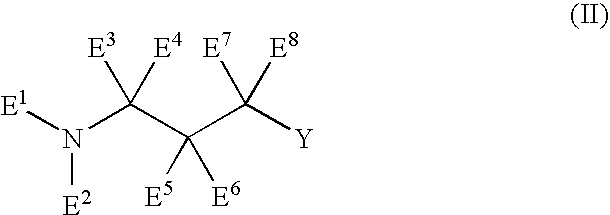Methods and fluorinated compositions for treating amyloid-related diseases
a technology of amyloid and composition, applied in the field of amyloid-related diseases, can solve the problems of toxic to subjects and hydrochloric acid
- Summary
- Abstract
- Description
- Claims
- Application Information
AI Technical Summary
Benefits of technology
Problems solved by technology
Method used
Image
Examples
examples
Binding Assay
[0330] The test compounds were synthesized and screened by mass spectrometry (“MS”) assays. The MS assay gives data on the ability of compounds to bind to proteins, in this example, to β-amyloid.
[0331] In the MS assay for Aβ40, the sample was prepared as an aqueous solution (adding 20% ethanol if necessary to solubilize in water), 200 μM of a test compound and 20 μM of solubilized Aβ40, or 400 μM of a test compound and 40 μM of solubilized Aβ40. The pH value of the sample was adjusted to 7.4 (±0.2) by addition of 0.1% aqueous sodium hydroxide. The solution was then analyzed by electrospray ionization mass spectrometry using a Waters ZQ 4000 mass spectrometer. The sample was introduced by direct infusion at a flow-rate of 25 μL / min within 2 hr. after sample preparation. The source temperature was kept at 70° C. and the cone voltage was 20 V for all the analysis. Data were processed using Masslynx 3.5 software. The MS assay gives data on the ability of compounds to bin...
PUM
| Property | Measurement | Unit |
|---|---|---|
| diameter | aaaaa | aaaaa |
| concentration | aaaaa | aaaaa |
| pH | aaaaa | aaaaa |
Abstract
Description
Claims
Application Information
 Login to View More
Login to View More - R&D
- Intellectual Property
- Life Sciences
- Materials
- Tech Scout
- Unparalleled Data Quality
- Higher Quality Content
- 60% Fewer Hallucinations
Browse by: Latest US Patents, China's latest patents, Technical Efficacy Thesaurus, Application Domain, Technology Topic, Popular Technical Reports.
© 2025 PatSnap. All rights reserved.Legal|Privacy policy|Modern Slavery Act Transparency Statement|Sitemap|About US| Contact US: help@patsnap.com



